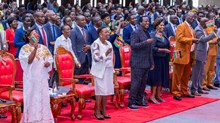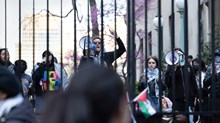The new U.S. Religious Landscape Survey from the Pew Forum on Religion & Public Life renders familiar territory remarkable. This poll of more than 35,000 American adults has produced a map of population centers (major religious traditions), the boundaries that separate them, and the thoroughfares that connect them. Among the highlights of the latest findings:
- Close to half (44 percent) of all Americans have changed religions or denominations at least once in their lifetimes.
- Protestants now make up just 51 percent of the population, though the total Christian population remains as high as 78 percent.
- Some 16 percent of American adults describe themselves as religiously "unaffiliated," more than twice the percentage who say they had no religious upbringing.
- In addition to contributing to religious diversity, immigration also augments the country's church rolls, as 46 percent of foreign-born adults claim Catholic identity and 24 percent claim Protestant identity.
The survey's topline summary describes this scene as "both very diverse and extremely fluid," which is an apt assessment as long as one remembers that the subject examined is a landscape and not, say, a moving crowd in an airport. For all of the often quite illuminating attention they get, non-Christian religions still constitute only about 5 percent of the American population. All religious groups are gaining and losing members in a very competitive environment, but the overall percentages remain fairly stable year to year and even decade to decade. Contrary to some solicitations for home missions, America is not going to become a minority Christian country anytime soon.
Why Evangelical United Methodists Don't Count
The Pew report contains much useful information for pastors, educators, and any Americans who wish to better understand the land in which they live. Zooming in on this map, though, accentuates some peculiarities of its provenance. When social scientists map religion, they usually rely on self-identification to classify respondents. The main category of classification for Christians is denomination. But how well does a denominational label locate someone within America's diverse and fluid religious culture?
Classification by denomination runs into real thickets in the large "Protestant" territory on the Pew map. This survey divides American Protestant churches into three categories: evangelical, mainline, and historically black. These encompass 26.3, 18.1, and 6.9 percent of the adult population, respectively. The necessity of separating out the black churches could be debated (are they significantly more distinctive than, say, Pentecostal churches or Hispanic Catholic churches?), but the much larger problem involves the other two categories. Simply put, "evangelical" and "mainline" identities do not break cleanly along denominational lines, and they never have.
The two labels present different difficulties. With "evangelical," the most problematic slippage occurs between self-identification and what could be called actual adherence. Broadly speaking, evangelicals care less about one's church affiliation than about one's beliefs (about Atonement, the inspiration of Scripture, and so forth) and behaviors (such as church attendance, daily devotions, and various measures of morality). Put differently, many evangelicals would not count as co-religionist persons who check the Southern Baptist or Church of Christ box on a survey, but could neither articulate nor affirm the Four Spiritual Laws. A self-identification survey cannot measure depth of commitment, but in the case of evangelicals, depth is a critical element of the identity as insiders understand it.
Imprecise definition of evangelicals skews all kinds of cultural analysis. The capacious definition that finds more than one-fourth of American adults to fit the label also lies behind headlines that claim evangelicals divorce and engage in extramarital sex at rates indistinguishable from those of the general population. John G. Stackhouse's critique of Ronald Sider's The Scandal of the Evangelical Conscience turns on precisely this point (Books & Culture, July/August 2007). Political analyses that assign a matrix of supposedly "evangelical" concerns to one-fourth of the electorate also falter. We're talking about a tradition in which a substantial portion of the congregations are not affiliated with any denomination, or any other church, in any formal way. Evangelicals do not lend themselves well to generalizations.
"Mainline" is an even more slippery label, one without much scholarly investigation or even history of usage. The term seems to have sprung fully formed into discourse around 1960 to describe mostly white, liberal, and middle- to upper-class churches with primarily northeastern roots. It is almost always used to describe whole churches or denominations, in contrast to "evangelical," which has more individual than institutional overtones. Basically, it is one of those words whose meaning seems obvious until you actually try to define it.
The largest contributors to the mainline total on the Pew survey are the United Methodist Church, the Evangelical Lutheran Church in America, the American Baptist Church, the Presbyterian Church in the USA, and the Episcopal Church. All of these churches fit the basic mainline profile, but they also have something else in common: all of them are embroiled in bitter controversies over the ordination of homosexuals and related issues of authority and biblical interpretation. Pew does count as evangelicals the survey respondents who choose one of these denominations but also self-identify as born-again or evangelical, but even this attempt fails to account for the internal diversity of the mainline. Clearly there are a lot of conservatives (if not card-carrying evangelicals) in these churches, else the fighting would have been over long ago.
The U.S. Religious Landscape Survey usefully conveys a lot of information about faith in America. But as it can be helpful to toggle between road, satellite, and terrain maps online, it is helpful to compare the image drawn by social scientists with images drawn by historians and theologians. Surveyors do not always see the historical patterns or theological values that matter most to other scholars or to religious Americans. As mapping sites remind us, directions are for planning purposes only. The reality on the ground can look quite different.
Elesha Coffman is a doctoral student in American religious history at Duke University. She is a former managing editor of Christian History magazine.
Copyright © 2008 Christianity Today. Click for reprint information.
Related Elsewhere:
The U.S. Religious Landscape Survey is available at the Pew Forum on Religion & Public Life's website.
Other news coverage includes:
America's Unfaithful Faithful | Americans are a religious people, but they switch religious groups with surprising frequency, a major new survey finds (Time)
Poll Finds a Fluid Religious Life in U.S. | More than a quarter of adult Americans have left their childhood faith for another religion or no religion. (The New York Times)
More in U.S. jump to new faiths, poll finds | The nation's long-held Protestant majority has slipped to 51%. Evangelicals make up the nation's single-largest tradition, followed by Catholics (Los Angeles Times)
In Major Poll, U.S. Religious Identity Appears Very Slippery (The Washington Post)
Survey: Americans freely change, or drop, their religions (USA Today)
The Changing Faiths of America | Study Shows Big Declines Among Major Denominations; A Boon for Evangelicals (The Wall Street Journal)
Religion Survey Finds Many Americans Swap Faiths (Morning Edition, NPR)
Study shows more Americans changing faiths beyond the one they grew up with | Nearly half change religious traditions, many to 'unaffiliated' (The Dallas Morning News)
Hispanics strengthen Catholic Church | Study: Immigrants buoy attendance while other denominations decline (The Orlando Sentinel)
Survey: US religious landscape in flux | The study released Monday by the Pew Forum on Religion and Public Life is unusual for it sheer scope (Associated Press)
Study Shows Racial Diversity Across U.S. Faiths | At least partial evidence that evangelical churches that were historically all white seem to be growing more diverse (Religion News Service)
'Unaffiliated' Show Biggest Change Among U.S. Faith Groups | But the "unaffiliated" aren't necessarily living out a strictly secular life (Religion News Service)
Catholics Lose More Faithful Than Any Other Group | Survey found that 31 percent of Americans were raised Catholic, but only 24 percent still identify as Catholic (Religion News Service)
Hindus Thrive as Buddhists Struggle to Pass on the Faith (Religion News Service)
Why Do Hindus Have the Highest Religious Retention Rate in the U.S? | Immigration issues seem to be an important part of the answer (Andrea Useem, ReligionWriter.com)

Support Our Work
Subscribe to CT for less than $4.25/month


















